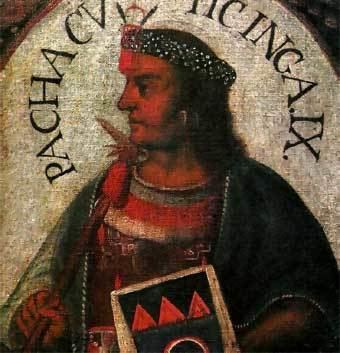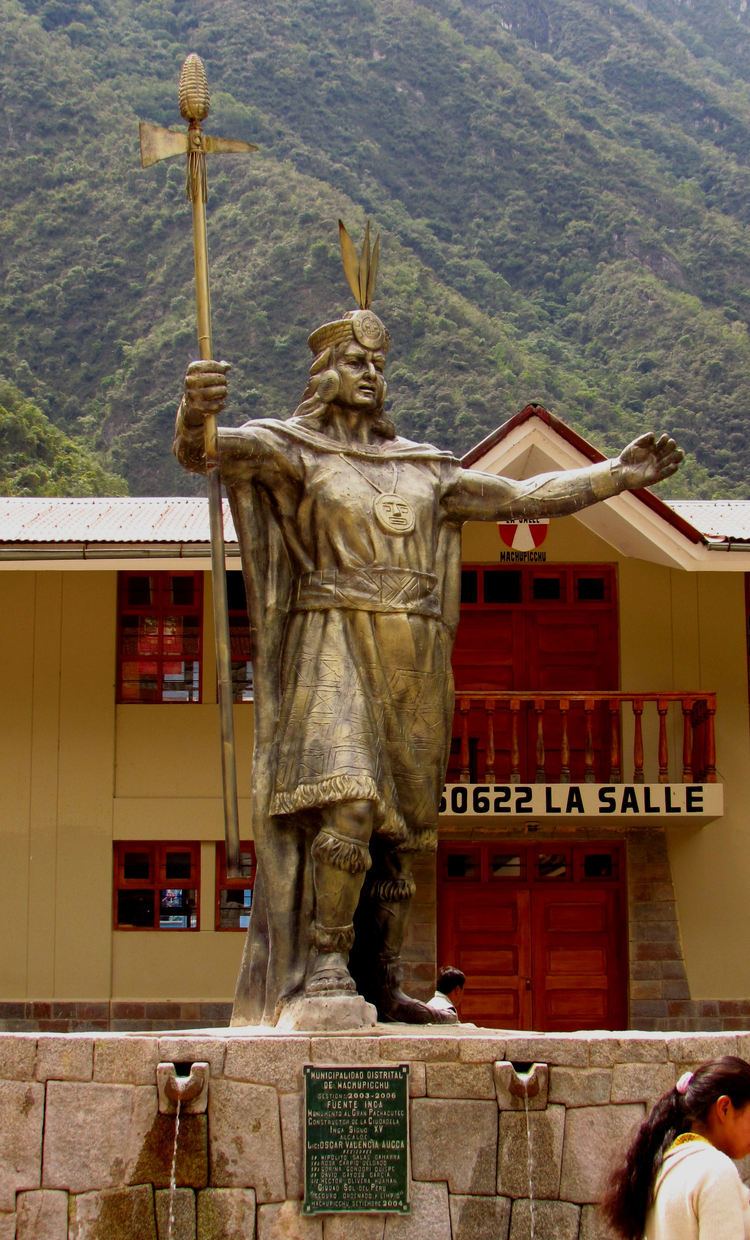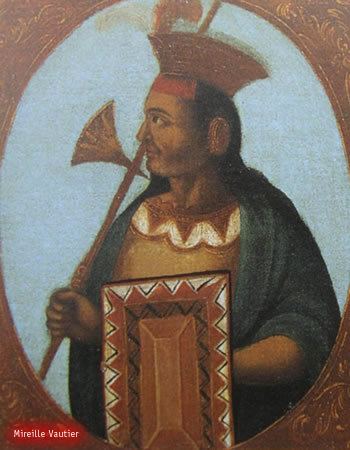Reign 1438–1471/1472 Grandchildren Huayna Capac Predecessor Viracocha Children Topa Inca Yupanqui | Name Pachacuti Yupanqui Successor Tupac Inca Yupanqui Grandparents Yawar Waqaq | |
 | ||
Full name Pachacuti Inca Yupanqui Consort Mama Anawarkhi or Quya Anawarkhi Issue Tupac Yupanqui, Amaru Yupanqui Quechua Pachakutiq Inka Yupanki Parents Mama Runtucaya, Viracocha Inca Similar People Topa Inca Yupanqui, Huayna Capac, Manco Capac, Viracocha Inca, Atahualpa | ||
Pachacuti
Pachacuti Inca Yupanqui or Pachakutiq Inka Yupanki (Quechua) was the ninth Sapa Inca (1438–1471/1472) of the Kingdom of Cusco which he transformed into the Inca Empire (Tawantinsuyu). Most archaeologists now believe that the famous Inca site of Machu Picchu was built as an estate for Pachacuti.
Contents

In Quechua Pachakutiq means "he who overturns space and time" (though more commonly translated as "earth shaker"), and Yupanki means "with honor". During his reign, Cusco grew from a hamlet into an empire that could compete with, and eventually overtake, the Chimú. He began an era of conquest that, within three generations, expanded the Inca dominion from the valley of Cusco to nearly the whole of western South America.

Biography

He was the ninth ruler of the Inca state who, from ruling a simple chiefdom, came to rule a great empire, the Tawantinsuyu. Although he had not been designated as successor by his father Viracocha Inca, he led a military defense against the warlike army of Chanka while his father and his brother Urco Inca fled the manor. The victory over the Chankas made Inca Viracocha recognize him as his successor around 1438.
As part of his vision of a statesman and warrior chieftain he conquered many ethnic groups and states, highlighting his conquest of the Collao that enhanced the prestige of the Inca Pachacutec. Due to the remarkable expansion of their domains he was considered an exceptional leader, enlivening glorious epic stories and hymns in tribute to his achievements. Numerous kurakas do not hesitate to recognize his skills and identify him as "son of the Sun".
He conquered the provinces of Colla-Suyu and Chinchay-Suyu. Along with his sons, Tupac Ayar Manco (or Amaru Tupac Inca), and Apu Paucar Usnu, he defeated the Collas. Additionally, he left garrisons in subjugated lands.
Lineage
Pachacuti, son of Inca Viracocha, was the fourth of the Hanan dynasty. His wife's name was Mama Anahuarqui, or Quya Anawarkhi (Coya Anahurque). He had three sons, Tupac Ayar Manco, Apu Paucar, and Tupac Inca Yupanqui.
Pacachuti had his two brothers, Ccapac Yupanqui and Huayana Yupanqui, killed after the military campaign against the province of Chinchay-Suyu. He also killed his sons Tilca Yupanqui and Auqui Yupanqui.
Amaru, the older son, was originally chosen to be co-regent and eventual successor. Pachacuti later chose Tupac Inca because Amaru was not a warrior. He was also the first one to retire.
Succession
Pachacuti's given name was Cusi Yupanqui and he was not supposed to succeed his father Inca Viracocha who had appointed his brother Urco as crown prince. However in the midst of an invasion of Cuzco by the Chankas, the Incas' traditional tribal archenemies, Pachacuti had a real opportunity to demonstrate his talent. While his father and brother fled the scene, Pachacuti rallied the army and prepared for a desperate defense of his homeland. In the resulting battle, the Chankas were defeated so severely that legend tells even the stones rose up to fight on Pachacuti's side. Thus "The Earth Shaker" won the support of his people and the recognition of his father as crown prince after the death of Urco.
Pachacuti rebuilt much of Cusco, designing it to serve the needs of an imperial city and as a representation of the empire. Each suyu had a sector of the city, centering on the road leading to that province; nobles and immigrants lived in the sector corresponding to their origin. Each sector was further divided into areas for the hanan (upper) and hurin (lower) moieties. Many of the most renowned monuments around Cuzco, such as the great sun temple Qurikancha, were rebuilt during Pachacuti's reign.
Despite his political and military talents, Pachacuti did not improve the system of succession. His son became the next Inca without any known dispute after Pachacuti died in 1471 due to a terminal illness, but in future generations, the next Inca had to gain control of the empire by winning enough support from the apos, priesthood, and military to win a civil war or intimidate anyone else from trying to wrest control of the empire.
Pachacuti is also credited with having displaced hundreds of thousands in massive programs of relocation and resettling them to colonize the most remote edges of his empire. These forced colonists were called mitimaes and represented the lowest place in the Incan social hierarchy. The Incan imperial government was highly authoritative and repressive.
He sent his son Tupac Inca Yupanqui an army to repeat his conquests and tyranny, and extend his realm to Quito. Pachacuti then built irrigating channels, cultivated terraces, made roads and hospices. The Road of the Inca stretched from Quito to Chile.
Pachacuti was a poet and the author of the Sacred Hymns of the Situa city purification ceremony. Pedro Sarmiento de Gamboa attributed one song to Pachacuti on his deathbed: "I was born as a lily in the garden, and like the lily I grew, as my age advanced / I became old and had to die, and so I withered and died."
